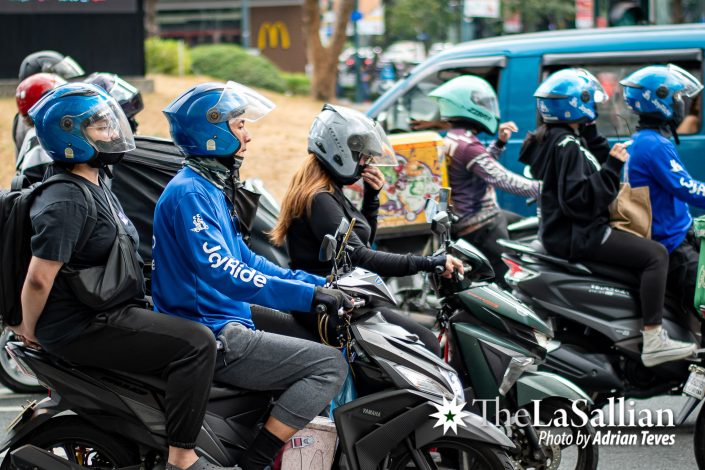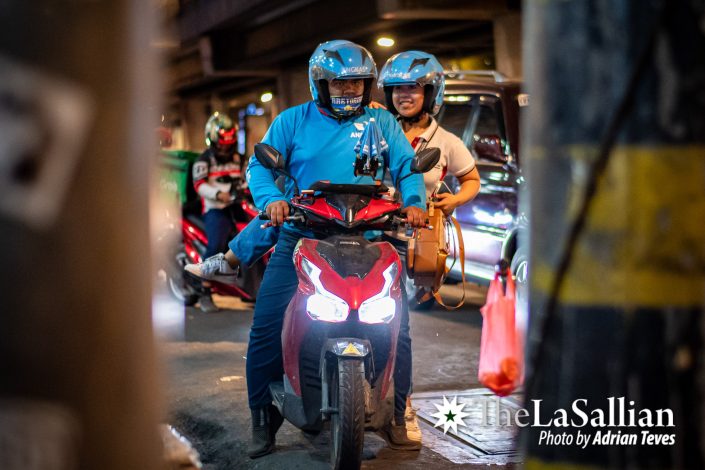Through the narrow side streets, weaving among cars and buses on highways, motorcycle (MC) taxis are a rising form of transportation within the Greater Manila Area. Characterized by their single-passenger capacity, these taxis navigate the city with agility and promptness, often making them a preferred commute for those in a rush.

“Habal-habal was the term [people] used to call it. They were also called informal transport, which is transport that [has] no policies supporting [or] regulating it,” civil engineer Ramir Angeles imparts on the history of MC taxis. At its core, this mode of transportation was born due to a need for a small-scale alternative that could bypass congested traffic. “It’s more common in some places than others, and usually these places are areas that are underserved by conventional public transport,” he adds. Where buses, UV express vehicles, and taxis are out of reach, MC taxis are ready to answer the commuter’s call.
The regularization of MC taxis through apps such as Angkas and JoyRide and the subsequent proliferation of their services evoke the question of how they fit into Philippine public transport. Amid traffic jams and overcrowded public utility vehicle (PUV) stations, MC taxis are a commuter’s saving grace in time crunches—but they only temporarily distract from the glaring shortcomings of the current transportation system.
Fast track
The services provided by MC taxis have solidified themselves as either a commuter’s primary or secondary transportation options due to their convenience. No longer having to walk toward bus, jeepney, or tricycle stops, MC taxi users can start and end the trip at their desired pick-up and drop-off locations.

“It’s more convenient for me because commuting is difficult, especially when you have a lot of materials you need to carry. […] I choose it because it’s also faster,” explains Christian* (II, BS-BIO), who frequently avails of MC taxi services. Christian’s commute by bus usually takes three hours, but when they opt for motorcycles, their travel time is cut by half.
Time serves as another factor in consumers’ preference for MC taxis. Due to the motorcycles’ smaller mass compared to three- or four-wheeled vehicles, they easily weave through traffic and cut down on customers’ travel times. For traditional transportation modes, travel time isn’t just determined by traffic congestion, but also by the number of people lined up ahead of you, explains Angeles. When the lines for trains or jeepneys are long, commuters are likely to start searching for an alternative, supplied by MC taxis.
But consumers are not the only group who benefits from this emerging mode of transportation, as tens of thousands of motorcycle riders now depend on MC taxi services as their primary livelihood. While he has only been a motorcycle rider for eight months, JoyRide driver partner Julius Perez sees the advantages of the job, explaining that his daily pay is fair for the workload. “‘Pag natapos ako sa pamasada ko po [at] kumita na’ko ng siguro mga isang libo na, uuwi na’ko tapos [babantayan] ko na ‘yung mga anak ko,” shares Perez.
(When I finish my shift and I’ve already made around P1,000, I’ll go home and then I will take care of my kids.)
The long and winding road
MC taxis have gained popularity in the face of issues like the impending PUV phaseout and the deteriorating state of other options. With this, the daily commuter might find the emergence of MC taxis to be a mere band-aid solution–an easy fix that diverts attention from improving public transportation to accommodate more passengers across longer routes.
This now challenges road planners and transport experts since the rate at which MC taxis are booming makes it difficult to place them in the grand scheme of things. “We have to start designing our roads for motorcycles. But that’s not something we hear every day,” points out Angeles. “How do you design a route for motorcycles? […] It’s a very Southeast Asian problem.” Such services hold little presence in countries with efficient public transport, implicating insufficient knowledge of how governments could handle a matter unique to certain regions of the world.
The motorcycle is also quite hazardous, hence why transport experts seek solutions beyond simply dividing up roads into lanes for specific vehicle types. Motorcycles leave riders fully exposed, unlike closed steel vehicles designed with life-saving features in cases of impact, making accident risks far more lethal. This is heightened by a few reckless riders who disregard road rules. “There are instances where I’ve had drivers who had definitely done illegal things, like they’ve turned left in intersections which are strictly no left turns just to get to the location faster,” comments Christian.
Yet, amid pressing concerns of road design and safety, Angeles laments, “It’s a bit of a frustration because [the government’s] not really keen on studying a lot of these things. They usually just hit the market forces [and] go.” Angeles comments on little movement from the Land Transportation Franchising and Regulatory Board to analyze the impact of MC taxis and write up clear-cut regulation policies for these.
Meanwhile, the Department of Transportation’s five-year ongoing pilot study on MC taxis has been largely rendered inconclusive. For one, it remains unclear how the rising volume of MC taxis will impact traffic, especially in the Metro. The absence of limitations gives the private handling companies liberty to continually deploy MC taxis, making it difficult to draw up an accurate number of how many are
currently operating.
An untrodden path
Motorcycle taxis are poised to fill in gaps in the transportation system while encouraging the depreciation of conventional modes of public transport. But who’s to say that we must pick one or the other when the current number of available commute options already fail to serve the needs of the Filipino people? Instead, MC taxis must be properly institutionalized to prove that it is not a replacement, but another option for daily commuters. Angeles remarks, “[It’s] increasing in number, and now the demand is always going to be there…So…we have to start designing our roads for motorcycles.”
Civil engineers must work together with the government to create roads better suited for MC taxis and all PUVs. On the MC taxi drivers’ end, further discipline and better knowledge of the road and operating vehicles are needed to ensure the safety of everyone—passengers, pedestrians, and riders alike. “Driving tests are for our own safety because other drivers don’t know how to properly drive a motorcycle or are too hot-headed on the road,” Perez relays in Filipino.
Motorcycle taxis are here to stay, but the bleak issues of overcapacity and PUV shortage continuously loom over the Philippines’ public transportation system. Improvements should be made on all fronts; convenience and accessibility should be given to commuters rather than optional factors of available avenues of transport. If we want to see a united Philippines, we must first build the bridges that will get us there.
*Names with asterisks (*) are pseudonyms
This article was published in The LaSallian‘s March 2024 issue. To read more, visit bit.ly/TLSMarch2024.
